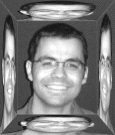Werner's slant contrast effect
|
The line patterns form the inducer and the random dots form the test-strip. The test-strip is identical in each of the stereograms. The test-strip contains no disparity so it ought to have no slant. However, when you view these stereograms with red/green glasses (red over left), the slant of the test-strip is different in each of the three stereograms. This is particularly clear once you compare the slants across the three stereograms. In this first stereogram the test-strip's left side appears to be closer than its right side. |
|
|
In this second stereogram the test-strip's left and right side appear to be equally close. |
|
|
In this third stereogram the test-strip's right side appears to be closer than its left side. Knowing that the test-strip is identical in each of the stereograms. How can it be perceived with opposite slants? van Ee, Banks & Backus (1999; An analysis of stereoscopic slant contrast. Perception, 28, 1121-1145) present a theory that predicts the perceived slants based upon the conflict between slant as specified by disparity and perspective. What did we do? In the first stereogram the inducer's perspective specified slant is zero and disparity specified slant is non-zero. In the second stereogram the inducer's perspective and disparity specified slants are consistent (and non-zero). The slant contrast effect upon the test-strip is greatly reduced. In the third stereogram the inducer's perspective specified slant is non-zero but the disparity specified slant is even more different from zero. |
|
